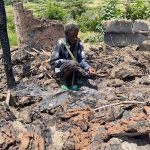In the dry hills of Xihaigu, it is as if the village of Banzigou never existed.
The only building left is the old local government headquarters, its gates barred with a rusted padlock.
A basketball hoop still stands outside, its net gone and its frame twisted from when they tried to pull it down.
Grass grows over the old court.
All the houses have been demolished and the trees planted in their place are struggling to grow.
The Xihaigu region, in the south of Ningxia province in north-central China, was always a tough place to live.
The UN described it as one of the most uninhabitable places on Earth back in 1972.
But for years people still eked out an existence, working the land, some of them living in cave-like houses carved out of the hills.
But temperatures have risen by 2.1 degrees Celsius over the last fifty years – twice the global average – with more than half of that increase happening between 2001 and 2010.
It is about the same temperature increase that the world is trying to avoid with the Paris Climate Agreement.
And it was enough to make an already difficult existence impossible.
Droughts have doubled in frequency over the same time.
“The land was very poor,” a former villager from the area called Mrs Ma told Sky News.
She used to live in a cave house she dug herself.
“There was no water from the land – it all depended on rainfall. And if it didn’t rain, the land would be dry and you would harvest nothing,” she said.
The World Bank estimates that 140 million people will be forced to migrate internally because of climate change by 2050.
In China, it is already happening.
Banzigou was abandoned, then destroyed.
Subscribe to ClimateCast on Spotify, Apple Podcasts, or Spreaker
The few remaining villagers left last year.
And there are scores of other ghost villages in the province.
1.23 million people have now left Ningxia’s arid south to move north to the basin of the Yellow River, whose waters make agriculture much easier.
Mrs Ma was one of the first to go, nearly 20 years ago.
The government paid her 1,200 RMB (in today’s value, roughly 1,880 RMB, worth about £200) to move to a new village called Yongxin.
Her family was given a house with two rooms and no water supply. Sandstorms would blow in every day.
Bit by bit, though, she improved her house.
Trees were planted to keep the sandstorms out.
And the village filled out, as more climate migrants arrived.
Now Mrs Ma has a large house and a yard filled with several cows and sheep.
“I don’t miss my old house now,” she says. “When I first moved here, I missed it sometimes. But now, no.”
China is the world’s biggest polluter and it is already having to mitigate the effects of climate change.
And if countries do not meet their climate targets, they will need to do the same.
The eerie still of Banzigou village feels like an ancient ruin.
It might also be a glimpse of our future.
Sky News broadcasts the first daily prime time news show dedicated to climate change.
Hosted by Anna Jones, The Daily Climate Show is following Sky News correspondents as they investigate how global warming is changing our landscape and how we all live our lives.
The show will also highlight solutions to the crisis and show how small changes can make a big difference.






















